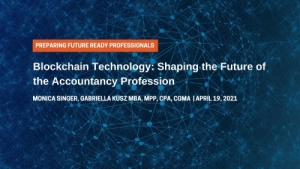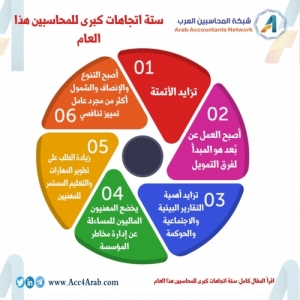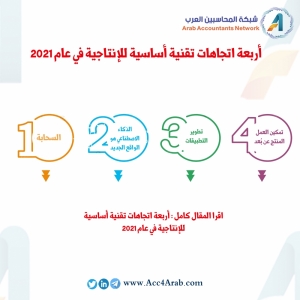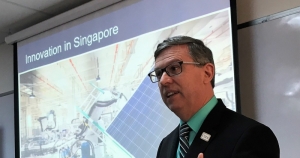عرض العناصر حسب علامة : الاتمتة
أربعة مفاهيم أساسية في جودة المراجعة
معلومات إضافية
-
المحتوى بالإنجليزية
4 key concepts in audit quality
April 5, 2021 3:15 PM
Facebook
Twitter
LinkedIn
Email
Show more sharing options
Quality is the “North Star” of PricewaterhouseCooper’s audit service, according to vice chair and assurance leader Wes Bricker, but it’s supported by four key concepts that advance the firm’s audit strategy.
1. Simplification
“Simplification is about taking unnecessary complexity out,” Bricker explained. “We have to actively think about how we simplify our end-to-end audit process. We’ve been very focused on that, and that impacts our people experience and that impacts our client experience; it takes the unnecessary complexity out so we can focus on the things that matter.”
2. Standardization
“That’s about taking a look at where we can work at scale on a centralized basis,” Bricker said, though he was quick to point out that, unlike many efforts at standardization, this is more about making sure all work is done at the same high level, and not about saving money. “It’s not a cost decision; it’s about consistency of execution, which contributes to quality.”
3. Specialization
“Specialization is about bringing in the right knowledge at the right points so that our people are spending time on areas that require the greatest judgment,” he explained. “Specialization helps us be relevant, because we’re working on areas of risk that have consequence to users of our service.”
4. Automation
“Automation is the last piece. Automation is how technology can harness points in the audit process to achieve synergy between our people and the machines that they use, so that the sum is greater than those individual parts,” Bricker said. “That takes a workforce that is upskilled that understands technology and its role; it also takes investments in technology so they have the tools, and then putting together people and technology to create something much greater than either of those individually, and helps us drive the process, deliver quality, increase the value, and create a better experience.”
For more, see our feature, “A new eye on audit quality.”
تقنية البلوكتشين Blockchain: تشكيل مستقبل مهنة المحاسبة
تشرح غابرييلا كوز Gabriella Kusz من IFAC ومونيكا سينجر Monica Singerالتكنولوجيا التي تقدم قيمة جديدة للمدققين والمهنة بشكل عام
معلومات إضافية
-
المحتوى بالإنجليزية
What Is Blockchain?
Blockchain is a technology that effectively connects people or companies in a direct way or on a peer-to-peer basis. For the past 20 years people have shared information through the internet. They have sent emails, posted to social media, and shared documents. Blockchain as a technology, takes the connectivity of the internet one step further. Blockchain offers users the internet of value.
As opposed to exchanging only information, participants can now also exchange value on a peer-to-peer basis. Although most commonly associated with Bitcoin and other cryptoassets, blockchain technology supports both applications (such as decentralized apps or dAPPs) and complex programming (such as smart contracts). It is through these smart contracts that blockchain offers the potential to easily and efficiently undertake a wide range of transactions and transference of rights and property.
Smart contracts can easily and cost effectively transfer ownership of a car or transfer corporate shares without needing a third party, such as a bank or a stockbroker, and with immediate settlement. It is this removal of “middlemen” by enabling trusted peer-to-peer exchange that is driving what some have come to refer to as “Web 3.0”, and the creation of $2 trillion of wealth in the last ten years.
Key Blockchain Features: Immutable and Decentralized
The key feature in blockchain is that anything that is stored on the blockchain is there forever, the information is immutable and cannot be erased. The information that is stored on the blockchain offers us a level of transparency that has not previously been seen. It means that if Person A owns something and transfers the ownership or value of it to Person B there will always be a record in the blockchain that Person A owned it. It also guarantees that the record cannot be manipulated—no one can change the record. This level of immutability is why blockchain technology is commonly referred to as a “trust machine”.
Another key feature of the technology is its decentralized nature. No one person, entity, or government owns or controls the information. This effectively means that Person A has a copy of all of their information as does Person B, and as does the next person. In a decentralized environment, all participants have access to the same information and users can then choose to share it or not. Information will no longer need to be aggregated and stored in central databases as it will be stored everywhere at once and, if desired, under direct user control rather than the company offering the service.
Through this transformation toward decentralization, the incidence of abuse of information as well as cyber attacks and hacking may be reduced if not entirely eliminated.
What Does This Have To Do With the Accountancy Profession?
Auditing requires the confirmation of transactions and balances on firms’ accounting ledgers at the end of the reporting period due to time-lags, reconciliations, and accounting entries. Each side of the transaction keeps its own records.
Blockchains and their almost immediate provision of an immutable record of transactions provides for shared transaction information, automatically synchronized across each location. Such a provision of information removes transaction level reconciliations and facilitates developing continuous auditing. For auditors, this offers the potential for a transition from a periodical or annual exercise to a continuous matter, one that can now encompass both parties to a transaction simultaneously.
As blockchains allow recording and settlement of transactions to occur at the same time as the transaction itself, auditors can obtain data in real-time and in a consistent, recurring format. Monitoring what happens in real time rather than testing (selectively) and reconciling what happened in retrospect is a substantial departure from contemporary audit techniques.
Due to distributed ledger technology, blockchain technology eliminates the need for entering accounting information into multiple databases and potentially removes the need for auditors to reconcile disparate ledgers. This could save substantial amounts of time and the risk of human error may be considerably reduced.
Reconciliation of accounting data will not be fully automated through blockchain technology as auditors’ professional expertise and experience is required to assess the accuracy of complex accounting transactions. However, the ability to trust that both parties are recording the same base transaction information and the real-time availability of this accounting data offers immense benefits for the efficiency with which accounting data can be reconciled and analyzed.
Imagine the power of this technology combined with Artificial Intelligence (AI) where the testing for discrepancies through analytical review could take place in real time and without the risk of missing transactions or the auditor having a blind spot in analyzing the information.
Looking Ahead
At its core, blockchain technology is a ledger system. It’s immutability and decentralized nature make it unique, but its function of recording transactions makes it familiar to those in the accountancy profession. To support the accountancy profession in understanding blockchain technology, the Accounting Blockchain Coalition (ABC)—a global coalition of representatives from blockchain industry leaders in the accounting, law, tax, technology and higher education—authors guidance on accounting for digital assets and currencies that run on blockchain technology. IFAC member organizations, including the Institute of Singapore Chartered Accountants, The Institute of Chartered Accountants of India, Institute of Chartered Accountants of England and Wales, CPA Canada, American Institute of CPAs, and South African Institute of Chartered Accountants, are building awareness of blockchain technology and digital assets, educating their membership and stakeholders, and offering insight or guidance in accounting and auditing for blockchain and digital assets. Developing professional knowledge and understanding of this emerging technology and its applications will be crucial to ensuring the profession’s relevance and future readiness.
في شركات المستقبل، يتحد الجميع معًا
إنها ظاهرة معروفة أنه عندما يتم تسخير خيول سحب معًا، فيمكنهما سحب ثلاثة أضعاف الوزن الذي يمكن لكل منهما سحبه على حدة. وبالمثل، فإن فريق كرة قدم عظيم، متحدًا في رؤيته وأهدافه، مع تركيز كل عضو في الفريق على دوره الخاص، سوف يتفوق على كل المنافسة في سعيه لتحقيق البطولة.
معلومات إضافية
-
المحتوى بالإنجليزية
In the firm of the future, everyone pulls together
By Alan Anderson, Dustin Hostetler
June 18, 2021, 9:00 a.m. EDT
6 Min Read
Facebook
Twitter
LinkedIn
Email
Show more sharing options
It’s a well-known phenomenon that when two draft horses are harnessed together, they can pull three times the weight that each can pull separately. Similarly, a great football team, united in its vision and goals, with each team member focused on their own role, will outplay any and all of the competition in its pursuit of a championship.
So why aren’t we applying that same synergy to our accounting firms?
Transformation into the firm of the future will require firms to be united in their vision and their goals. This means alignment not only in the services they provide clients, but also how clients experience working with firms, and how staff members experience working at those firms. Business owners, clients, and employees already all expect more than a transactional relationship — they want something that is relevant to their personal wants and needs and that adds value beyond the price they pay. In our work with firms, we have noticed that firms tend to have challenges with alignment that prevent them from working seamlessly together for the benefit of their clients.
Inflo Digital Audit: The profession's first end-to-end digital audit platform
Do more with data, automate compliance, and improve your value with Inflo’s Digital Audit -- the accounting profession's first data driven audit solution...
SPONSOR CONTENT FROM INFLO
Currently, tax and audit tend to operate in silos, not sharing information or firmwide goals. Businesses that work with both tax and audit tend to have a schizophrenic experience in their interactions with an accounting firm. One side will request documents and information that has already been supplied to the other side, but most likely in a different format. One side wants the trial balance in Excel, while the other side wants login information for QuickBooks Online.
This makes a poor experience for clients and staff alike. Staff who move from tax to audit or vice versa may experience cultures as distinct as working for a completely different firm and may be told that the other area is the “Dark Side.”
Compliance services will not be going away, but those services are being priced as commodities. Declining margins, fee pressure, automation, and offshoring mean firms that only provide the bare-bones services of tax returns and audited financials are in a race to the bottom. When that bottom is reached, who will be able to afford to do that work?
Ignoring the keys to the kingdom
Thanks to technology, the current core services of tax and audit give us the keys to the kingdom from which to extract value for our clients. We have tools that let us drill down to the details of every transaction and look under every rock to see what’s there. Simple tools like Excel, and more complex ones that use artificial intelligence, can help us see trends and issues that human eyes, looking at the numbers, cannot detect.
But even with this great store of knowledge at our fingertips, time pressure keeps us from looking under the rocks. Most firms use technology merely to replicate what they did in a paper world, not to free up time to look under those rocks.
Our core services should serve as a springboard for improving our clients’ businesses. Instead, we drop the ball. We could be leveraging our business-mindedness from working with other clients to provide high-value ideas, but we rarely discuss those powerful insights with clients or with others in the firm. Rather than sharing the insights we gain, we move quickly to the next project and the next client.
Our vision for the firm of the future
We believe that to remain viable, accounting firms will need to transform from separate tax and audit departments into a unified whole, focused on advisory services. Leaders of tax and A&A need to come together to merge their firms into a cohesive team, aligned to the same firmwide vision. Both sides need to move together in sync to make transformation happen. This will require changes to people, processes, and systems.
Compliance will remain the base of services — it’s not going away. But this will be tax, audit and accounting with a strategic bent. The annual deliverables — whether that’s a tax return or an audit or both — will be accompanied by additional services. At the base advisory level, regular work and client meetings will be performed both before and after the tax return or audit to establish a rhythm of planning and strategy throughout the year. The next level up will be one-off consulting services on an as-needed basis. These consulting services could include any of the following:
Data metrics and analytics;
KPI monitoring with a custom dashboard;
Succession planning;
M&A support, including business valuation;
Cybersecurity and IT consulting; and,
Bonus plan evaluation.
The firm of the future will also follow the “one firm” model with alignment between tax, audit, and the firm’s vision. Clients will have a better and consistent experience across core services due to increased collaboration between those services. Tax and audit will share information and technology know-how so that everyone is working from the same playbook. All parts of the firm will be moving ahead into the future in synchrony.
Benefits of creating the firm of the future
By creating a unified experience across the firm, everyone — clients, staff, and partners — will have a better experience. Making full use of technology tools will help everyone work smarter, not harder. Instead of just replicating the paper world, innovative uses of technology will introduce new methods for getting the work done effectively and efficiently. Team members won’t be mindlessly filling out the same checklists and forms to get the work out the door faster, but will be empowered to look under every rock, to think, and to make connections. No longer in a race to the deadline, they will leverage the business-mindedness that they have acquired from working with other clients who have the same issues but solve them differently. The goal of every engagement will be to create value for clients through insights and ideas to make their businesses better.
Firms need fewer clients when they layer high-value advisory services onto commodity compliance services. Instead of 100 mediocre clients, maybe you’ll only need 20 great clients. That $800 tax return can be leveraged into $1,500 for tax strategy and planning. An audit with a fee of $20,000 can be doubled when you add in additional advisory and consulting.
Client retention improves vastly when the necessary evil of compliance is transformed into an essential service that helps clients grow their businesses. For clients who see value in what you provide, cost becomes a non-issue. They become sticky to the firm, and not necessarily to a particular partner or manager because the combination of services from a unified firm is greater than any one part on its own.
Besides retaining your best clients, you’ll have better staff retention, an important consideration today when the pipeline for new talent isn’t keeping up with demand. You’ll keep the inquisitive people and the ones who want to make a difference in their clients’ lives. A firm that shares a unitary and forward-thinking vision will be attractive to people who seek work with more meaning.
A unified, forward-thinking firm will also have the resiliency to absorb the future legal, regulatory, and technology changes that we all know are coming. Technology and AI will take over the bottom-level compliance work, but a firm aligned around advisory services will still be able to provide the much-needed and highly valued strategies and insights that our clients themselves will require to remain viable in our rapidly changing world.
Until now, tax and audit have largely worked independently, limiting our ability to propel our clients toward success. But enhanced alignment between these service lines around a common vision will harness a firm’s combined skills and wisdom, to create a firm that is much more than the sum of its parts. Like a team of draft horses, this combined focus will help power the changes that we and our clients will need to thrive in the future.
إنفوجرافيك.. ستة اتجاهات كبرى للمحاسبين هذا العام
يتوقع الرئيس والمدير التنفيذي لمعهد المحاسبين الإداريين جيف طومسون ستة اتجاهات كبرى في مهنة المالية والمحاسبة هذا العام.
استشارات الميزانية للمحاسبين لعام 2021
معلومات إضافية
-
المحتوى بالإنجليزية
Budgeting advice for accountants for 2021
By Helen Braswell Kakouris
Given the turbulence of the past year, agility should be at the forefront of our minds when building a budget and strategy for 2021. Business owners need to be prepared to navigate the continued uncertainty. The ability to pivot in an unpredictable business environment will be essential this year, and with revenue assumptions changed across all industries by the events of 2020, a fresh approach is needed.
The industry can look to PwC’s advice: “Protect growth and profitability through actions such as scenario planning [and] more frequent financial modeling exercises to improve resiliency.” It is time to shift the approach to the new environment, with small and medium-sized companies now requiring quarterly or monthly strategic advice. This will transform the way that the industry offers its services, with strategy and consulting services offered as a monthly retainer, pushing away from the traditional per hour format. With the software advances of recent years, switching accounting pricing models can be a near seamless transition.
Historically, only large enterprise companies had the means to invest in quality software to enhance their decision-making capabilities for strategy and budgeting. Small and medium-sized enterprises in contrast often relied on a semi-annual conversation with their CPA. In the last few years, countless new software products have come to the market geared toward SMEs. There has never been a more important time for accountants to look ahead and prepare themselves for strategy-based budgeting conversations rather than historical budgeting.
Managing Your Firm in a Post-COVID World
Think beyond the pandemic with exclusive resources to help you build a thriving virtual practice.
SPONSORED BY INTUIT ACCOUNTANTS
First, let’s run through the ground rules for forming a budget, before looking more specifically at how the 2021 budget should differ.
The basics
When forming a budget, it has to align with the company’s vision and goals. Are the vision and goals specific, measurable, achievable, time-based and relevant? This is the S.M.A.R.T. acronym from a paper published by George Doron almost four decades ago. A well-formulated goal could be something like, “I want to increase company sales by 30 percent by the end of 2021.”
Understand the executive team: What is their management style? Are they aggressive or conservative? That will ultimately decide whether they are willing to absorb losses in order to achieve their growth goals and thus will shape the budget and give a clear picture on raising or securing necessary capital. Understanding management style and the decision-making approach is really a personal question for every business owner, which must be reflected on individually.
Get specific with the industry. Think about the industry and economic factors that will affect the company’s operations in the coming year. Naturally the whole business world has been radically changed by the events of 2020, but its effects will be distinct across different industries.
Consider the company’s overall revenue goal. Is it hoping to offer new products or services? If management wants to increase sales, perhaps it needs new sales personnel, and the budgeted payroll expense will likely depend on their level of experience.
Consider the company’s costs: Do they need greater inventory to satisfy orders? What is the staffing cost required for increased sales, or even the cost of outsourcing some tasks? Also, try to predict upcoming costs, like any equipment purchases that could be beneficial.
The last ground rule for forming a budget is to choose a budget framework — a historical budget or a zero-based budget. In normal times, a hybrid budget would be recommended, with historical data as a base to develop revenue and payroll, and all other expenses using the zeroed-out approach. However, the 2021 approach to budgeting is going to challenge the traditional ways.
The 2021 approach
A new business environment demands a fresh approach to budgeting. Zero-based budgeting should be the preferred framework, prioritized over the historical data approach. In fact, McKinsey even echoed this point in a recent study.
The historical data approach could be misleading this year. 2020 may have been a statistically anomalous year, meaning the data produced in the most recent year, which would usually carry the most weight, is difficult to utilize.
In building a budget, assumptions are one of the most important components because those will drive total annual budgeted revenue and expenses, and thus shape the entire report. For 2021, those assumptions are even more important and should be afforded greater scrutiny. Geographical and seasonal variables also require particular attention. With greater market fluctuations expected amid an unpredictable political and economic environment, accountants must make themselves available for up-to-the-minute advice. Businesses will need them to be on hand to review and adjust budgets throughout the year, to help adapt to environmental changes as they come.
The accountants who build that trust are likely to have a profitable 2021 and beyond. They should consider changing their own pricing model to a monthly retainer, rather than a by-the-hour model, so their company involvement can be more consistent and available for pivoting throughout the year.
In addition, the increase in automation is compounding the need for the new pricing model. Much of the traditional bread and butter work of accountants is being automated, meaning the professional role is becoming increasingly advisory, with trust key to the relationship. Accountants should realize where the industry is headed, and get ahead of the game.
Those professionals should consider acting as a strategic partner to businesses rather than a professional who gets called in for projects or regulatory requirements. While the ground rules remain an important point of reference, the 2021 budget demands the industry adapt to an unfamiliar economic environment. Being in such unchartered waters heightens the importance of the zero-based budgeting framework and requires deep thought on every single assumption included in the budget.
Accountants will be trusted with a weighty responsibility as their clients navigate and profit from an unpredictable 2021. Those who are on hand to course a way through choppy waters are sure to develop great relationships with their clients and gain a solid reputation in the industry.
فتح الصندوق الأسود للذكاء الاصطناعي
معلومات إضافية
-
المحتوى بالإنجليزية
AI, applied: Opening the black box
By Ranica Arrowsmith
There’s a phrase for the uneasiness many of us feel when confronted with humanlike machines — the Uncanny Valley. Coined in the 1970s by Tokyo robotics professor Masahiro Mori, the phrase describes how as machines appear more humanlike, they become more appealing to humans — but only up to a point. After that, as they appear more humanlike but not quite, they inspire revulsion in the observer.
In the accounting profession, there is a similar uneasiness when dealing with the idea of AI, though it has nothing to with how the software looks. The technology has the potential for high-level automation of processes, ultimately saving a lot of time for the accountant, but with its ability to perform tasks that are traditionally the purview of human beings, does this mean a diminished role for the accountant, or even the loss of jobs?
The good news is, the experts don’t think so.
Justin Adams, whose company Anduin has just launched an AI-enabled accounts receivable platform, insists there is an “art” to billing that must remain in the AR process for it to be meaningful and profitable — the deep knowledge of a client over time, for example, can affect a billing relationship. And Samantha Bowling of Garbelman Winslow CPAs isn’t interested in simply speeding up the audit with AI — she wants to provide an audit of such high quality that it’s unquestionable. These types of service goals can only be achieved by marrying AI with the human professional, with all the professional’s experience, skepticism and emotional intelligence.
Artificial intelligence can have an air of mystery about it, to say nothing of a hint of the unnatural, with something we value as inherently human — intelligence — being created and inserted into something inanimate — a machine.
It makes sense that we feel this way. The programming precursor to what we today call artificial intelligence was neural networks, code that was inspired by and modeled on actual human neural networks in the brain. Today, artificially intelligent programs have the ability to observe patterns and use those to “learn” behaviors and responses, making the technology smarter and more usable over time.
It’s worth bearing in mind the various ways in which AI is already here, working in the background of the accounting and enterprise platforms you know well, automating processes and making software more efficient. All the user sees are the benefits. But the market is now seeing true AI platforms that apply machine learning to entire processes end to end, such as AR/AP. And the common theme among all use cases for such AI-rich platforms is time — the time it takes to adopt the software and to validate it, to train it enough for a firm to realize its benefits. The machine has to learn. This takes an investment both of money and patience, but for the willing, it’s worth it.
Today, artificial intelligence is transforming processes across the accounting profession, for those are ready to invest in and adopt it. It’s not just being practically applied in audit, where AI is being used for data analysis and anomaly detection — we will look at examples of AI transforming AR/AP, as well as explore the implications of AI in sales tax automation.
Accounts: Receivable
Despite … everything about this year, venture capital funding continued on an upward trend in 2020, with the third fiscal quarter bringing in the second highest amount of VC funding per quarter on record. Artificial intelligence is high on the list of hot tech, which makes it no surprise that Anduin was able to obtain seed funding and launch its first AI-powered product suite all during the COVID-19 pandemic.
Anduin co-founders Justin Adams and Pat Morrell have built an AI-driven accounts receivable platform, Intelligence-Based Billing, for accounting firms. The platform launched in December, so it remains to be seen how successful adoption will be, but the pair of entrepreneurs have succeeded before in the AI space. Prior to founding Anduin, Adams and Morrell started, grew and sold a company that made an AI-driven product for the health care space, all within two years. That whirlwind experience propelled them into their current venture, and their success made them attractive prospects for investors.
“We had zero health care background when we started Digitize.AI,” Morrell said. “But we went to CFOs of health care companies and asked them where their biggest pain point was. When they said ‘prior authorizations,’ I had to look it up on Wikipedia — but I knew that a manual process is a manual process, and can be automated.”
Adams and Morrell weren’t quite as clueless entering the accounting space. Adams had spent years working at Big Four firm PwC, first in a consultative capacity and then internally managing technology projects. When they asked accountants what they would change if they could wave a magic wand, accounts receivable was a common answer. The process, managed manually, is scattered and unwieldy, and even streamlined client portals don’t optimize the process for each individual client and their payment habits.
There’s an art to billing, Adams said, and the platform tries to preserve that for the accountant. “Think of it from a client’s perspective,” he said. “There’s tons of friction. It can be confusing. You could have received a service three months earlier, and when you get the invoice, you’re trying to remember what you’re paying for again.”
Intelligence-Based Billing is made up of four modules (which can be bought separately), handling invoicing, collection, payments and internal analytics. The platform automates the invoicing process so bills are sent in a timely manner, but it also learns a client’s payment habits over time. How many emails or messages does it take before an invoice is opened and viewed? How many contacts does it take before a client pays the bill? Each client is different, and therein lies the art. If a client typically pays an invoice after two emails and a phone call, Intelligence-Based Billing will “remember” that over time, optimizing the process for each firm-client relationship.
More “art” that the AI tries to replicate: The analytics feature can be used in part to automate, so to speak, that gut feeling accountants also have to pay attention to when it comes to value-based billing. For instance, Morrell pointed out, a firm may have worked a certain number of hours on a project, but with their sense of the market over the years, they know that a client might expect a certain discount. Each client perceives different aspects of a service as more valuable, and also might need different billing structures to remain a client in the long term. Intelligence-Based Billing pulls and analyzes data from across firm systems to inform this type of decision-making.
“The fundamental pain is the anxiety that firms are leaving money on the table; and that firms don’t have real visibility into their cash flows,” Morrell said. “On the partner level, it’s all about liberating them to focus on complex, creative, value-generating service delivery.”
Intelligence-Based Billing is new on the market, and is signing up “trailblazer firms” now as its first customers. Time will tell how successful it will be, but no matter what, Anduin is part of a small group of innovators bringing fully formed, AI-enabled automation to firms of all sizes, for everyday firm functions, and will help set the stage for what’s to come.
Accounts: Payable
Youngseung Kuk manages business outsourcing services for Top 100 Firm Armanino in Boise, Idaho. This year, Kuk spearheaded the implementation of Vic.ai, a platform that automates the accounts payable process using AI. Using AI to tackle AP for clients was “low-hanging fruit,” Kuk said, as all companies, no matter what type, have bills to pay.
Armanino uses Bill.com firmwide for all AP, so the firm worked with Vic.ai to integrate the software to make the end-to-end AP process more streamlined.
Kuk and his team are validating Vic.ai as they use it, adding clients slowly, one at a time, to make sure they give the program enough time to learn its clients and become highly efficient at its predictions. This is a key part of understanding AI — it takes time.
Software that runs on AI doesn’t operate like the software we’ve become accustomed to. It doesn’t perform an exact set of functions as programmed, and only as programmed. Artificial intelligence learns as it goes, which means that by the end of a certain period of time, the software will operate very differently for each client, each firm, each project.
Kuk estimates it will take Vic.ai three years to predict client behavior and needs at a close-to-perfect rate. The wait is worth it for the sheer amount of time it can give back to an accountant once the AP process for a client is basically fully automated.
Armanino has one client, a law firm, that has highly repetitive bills that don’t have too many complicated dimensions (i.e., company name, address, and so on, are usually in the same spot on the invoices). Within a few months of use, Vic.ai can now predict any given AP workflow for that client with about 80 percent accuracy. If this is true for this client, Kuk said, that’s enough to know it’s possible for the others. Currently, Armanino has 46 clients on Vic.ai, and plans to keep validating the software so it can add more in time.
“The time spent validating is worth it, because by the end, as a firm, we’re going to be so much more scalable,” Kuk said. “Once you free up some capacity, even just from an AP standpoint we can do a number of different things for our clients that add more value, like confirming all vendors have W-9s, for example, or reaching out to vendors proactively if they haven’t accepted an ACH payment. These are just some basic examples, but I think we’re at the tip of the iceberg and nowhere near the full potential of AI.”
“Two years ago, we made an investment in artificial intelligence in a big way. It became part of firmwide strategy,” explained Tom Mescall, partner-in-charge of consulting at the firm. “Most CEOs, CFOs and business operators know the headline of AI, but they don’t know how to apply it in a business setting. We’ve done a lot of work around demystifying AI and bringing real-world examples to light for clients.”
A relevant audit
Firms have been using AI products for anomaly detection and analytics in audit for a few years now. Companies like MindBridge AI came on the scene and started to show the profession the real-world implications of being able to read every piece of data in minutes, as opposed to just sampling data. Samantha Bowling, a partner at Garbelman Winslow CPAs, saw the opportunity in MindBridge AI three years ago, and brought the technology to her firm.
In 2017, while Bowling served on the Governing Council for the American Institute of CPAs, she listened to president and CEO Barry Melancon describe how Big Four firm KPMG was investing millions of dollars into AI-driven audit technology.
“He was talking about how they were going to take over the world,” Bowling recalled. “As a small-firm audit partner, I was concerned, because if the big firms are doing something, sometimes it doesn’t become available to us for a while, or ever. I was actually concerned about eventually having to find a new revenue source.”
She called her existing audit software provider and asked explicitly if they had plans to embed AI into their platform. They didn’t. So Bowling did some online research and found MindBridge AI.
Bowling says that Garbelman Winslow is still in the adoption phase of MindBridge. As is true with the other technologies featured here, there is no substitute for time to allow an artificial intelligence platform to live up to its true potential. She started by engaging MindBridge for just one audit, and then grew usage from there. It helped when MindBridge integrated with QuickBooks, which made data transfers easier.
The biggest benefit of applying artificial intelligence to audit, for Bowling, is the risk analysis.
“Now that there is a direct link between QuickBooks Online and MindBridge, it automatically connects and does the risk analysis,” Bowling said. “I used to think MindBridge was an audit stamping tool that looked at transactions and identified anomalies, directing our attention and telling us where to look. But I realized it’s actually a great risk assessment tool in the very beginning of an audit.”
Bowling explained that while audits are based in risk assessment, a lot of the time, auditors have no idea where the risk is. “We only have our professional skepticism — there’s no one to tell us the risk is in revenue or payroll,” she said. “Now we have something that tells us where it is at the outset. Audit assertions are built into it.”
But there is friction in adoption. Not every client is easy to work with in MindBridge. There is still a lot of manual work to be done to transfer data that is not in the cloud, for instance, to MindBridge AI’s platform.
“Everyone just wants it to be an easy thing — to upload the general ledger and get going — but I think they’d be remiss not to do this with at least one client, or start with their cloud-based clients first before going to challenging clients,” Bowling said. “People are looking for faster, better ways, but I went into this not to do a faster audit but a relevant audit.”
Bowling received CPA.com’s Innovative Practitioner Award in 2018 for her work bringing AI to Garbelman Winslow CPAs. She won in part for the fact that it is small business and nonprofit clients to which she is bringing AI-enabled services, which also has the side benefit of Bowling being able to pass the cost of using MindBridge to her clients by folding it into the billing package. Nonprofit clients don’t mind paying top dollar for service that guarantees an accurate risk assessment.
“Nonprofit clients don’t care about us passing the fee onto them to minimize risk as much as we do, because nonprofit board members are just worried about someone doing something wrong with the money and it being in the newspaper,” Bowling said. “So they’re happy to have a very good audit done, and pay for it.”
Every transaction in the world
When thinking about the application for artificial intelligence in tax, often we think about tax preparation, since there is a lot of room to automate it. In fact, Samantha Bowling said that if she could apply AI to any other service area at her firm, it would be tax: “The current process, with a mix of paper documents and e-returns, is asinine,” she said. “I can’t wait till the whole process is 100 percent automated.”
AI-related innovation in tax prep is moving slowly, although the Internal Revenue Service has started to use the technology in different capacities to detect tax evasion and other types of noncompliance. But of course, there are other areas of tax that are ripe for disruption with AI, and sales tax automation is one.
One of the companies working in this area, Avalara, has made investments in AI in recent years, one of which was acquiring Indix in 2019. Indix was based on an idea that founder Sanjay Parthasarathy had for creating a comprehensive index of retail product information online using artificial intelligence to aggregate the data. (The aggregator was built in layers, with a Google web crawler grabbing information from all over the internet, and then various smart algorithms working together to curate and organize that data.)
Brands and retailers could buy access to this database of information on mostly retail, but also some business-to-business, products, to enrich their catalogs, benchmark against competitors, and so on. Basically, Indix was built as a neutral aggregator of e-commerce inventory.
And now, Avalara owns that AI-built index of more than 4 billion products. This means that Avalara can fold categorization data for much of the world’s online inventory of products in with its tax content database, which includes international product codes and classifications; taxability rules; exemption conditions; tax holidays; jurisdictions; boundaries; tax rates; thresholds and registration, compliance, and return preparation and filing requirements.
If this list sounds daunting, that’s kind of the point: Avalara’s mission is to “to be a part of every transaction in the world.” Without AI enabling at least some of this technology, this would be an impossible goal.
“When you buy a tax compliance product or suite, you want to be able to start using it tomorrow,” said Parthasarathy, who now serves as chief product officer for Avalara. “However, you know that before you can use an automated system, you have to make sure the tax nexus is right, the catalog is mapped to the tax code, a set of things that take time and research. If you want to start selling internationally, and you therefore need to start using harmonized tax codes — if it’s going to take nine months to do it, that’s lost value. We can get you going right away.”
Before Parthasarathy founded Indix, he spent almost two decades at Microsoft. He ended his career there in 2009 as corporate vice president of the Startup Business Accelerator program, a program he created; and he was director of Bill Gates’ 1997 trip to India, which led to a significant investment in that country by the software giant.
When talking about historical AI, Parthasarathy will sometimes use the term neural networks, which are indeed the statistical model programs ancestor to what we call AI today. His knowledge of AI is deep and historical, from having spent so many years helping build one of the most innovative companies in recent history. From his vantage point, he sees both the immense possibilities of AI, as well as the risks.
“There are risks in tax — compliance has potential penalties if done incorrectly,” he commented. “You’re doing it on behalf of somebody, so you want to make sure it is accurate and appropriate. You probably want actual people to keep an eye on it, rather than let AI run everything, even if one day it can. There is an ethical risk — when you have all this data, what is the responsibility of the government and companies to treat it as private data?”
إنفوجرافيك.. أربعة اتجاهات تقنية أساسية للإنتاجية في عام 2021
توقعات الرؤساء الماليين في السوق المتوسطة لعام 2021
معلومات إضافية
-
المحتوى بالإنجليزية
Midmarket CFOs expect revenue growth in 2021
By Michael Cohn
A majority of middle-market CFOs are predicting an economic recovery and revenue increases for their companies in 2021, according to a new survey by BDO USA.
The 2021 BDO Middle Market CFO Outlook Survey, found that 60 percent of the 600 CFOs polled at midsized companies anticipate economic recovery, while 56 percent expect revenue increases, in 2021. In addition, 62 percent of the survey respondents anticipate their company will be thriving a year from now.
Nearly three-fourths of the middle-market CFOs said their companies received government assistance as a result of the crisis. Cost cutting and reorganization for resilience are the top priorities for many CFOs.
The pandemic made an impact on nearly every company, and 39 percent of the CFOs polled indicate that the pandemic accelerated digital transformation at their companies, while 38 percent said it opened new expansion opportunities for products or services and 31 percent for new geographies.
“Unprecedented was the buzzword in 2020 for good reason,” said BDO USA CEO Wayne Berson in a statement. “Many middle-market companies persevered through levels of transformation and disruption in one year akin to what some companies experience in a full lifecycle. But rather than hunker down and endure, middle market leaders endeavor to move forward to refresh strategy and enhance agility. While we’re not out of the woods, the middle market is poised to pivot to new levels of potential.”
Deal flow was unsteady last year as CFOs assessed and reassessed the possible outcomes of the pandemic’s impact on their business. However, CFOs appear to be more optimistic this year, with 29 percent planning to seek private equity investment, 24 percent want a merger or acquisition and 20 percent hope to pursue an IPO.
While returning to the office or floor is critical for many CFOs, 43 percent of the respondents said they would increase or establish permanent remote work options. Office space is likely to be downsized, with 28 percent of the CFOs polled planning to eliminate or consolidate their current real estate footprint. CFOs also intend to build a more flexible workforce through automation (38 percent) and outsourcing (32 percent).
The main threats cited by the CFOs include a prolonged economic downturn, competitive pressure, supply chain disruption and falling behind on technology or innovation.
Coming out of an election year, tax challenges are also going to be important, with understanding total tax liability (19 percent) and navigating shifting trade and tariff policies (17 percent) among the top challenges cited by the CFOs. Managing disclosures and risk factors is also a top financial reporting challenge as the CFOs try to assess how to communicate impact of COVID-19 on matters that may be material to stakeholders.
ستة اتجاهات كبرى للمحاسبين هذا العام
معلومات إضافية
-
المحتوى بالإنجليزية
IMA CEO sees 6 ‘megatrends’ for accountants this year
By Michael Cohn
Institute of Management Accountants president and CEO Jeff Thomson is predicting six megatrends in the finance and accounting profession this year.
They include:
An increasing amount of automation;
Remote work becoming the norm for finance teams;
Environmental, social and governance reporting growing in importance;
Finance professionals being held accountable for enterprise risk management;
Diversity, equity and inclusion becoming more of a competitive differentiator, in addition to being the right thing to do; and,
Increasing demand for upskilling and continuing education for professionals.
Many of the trends are ones seen in years past, but are likely to grow in importance this year as organizations deal with the ongoing COVID-19 pandemic and face challenges in implementing technology and responding to demands for a diverse workforce and the threats posed by climate change, he explained.
Institute of Management Accountants president and CEO Jeff ThomsonCourtesy of the IMA
“Organizations and their CFOs have to continue to build their balance sheets, continue to invest in the future, build their talent pipeline, invest in automation and analytics, and service that pent up demand,” said Thomson. “Continue to build their teams and service that demand. Invest in technology, RPA and automation tools.”
Over the past year, he has seen remote work take hold as a way to cope with the pandemic, but some organizations are incorporating hybrid models combining two or three days of work in the office and two or three days of work from home.
“That means you have the automation tools, collaboration tools, discipline and taxonomies to make sure that people kind of understand the protocols,” said Thomson.
ESG reporting has grown in popularity as more companies try to demonstrate how they are responding to climate change and social issues in response to investor demands for greater accountability. Thomson sees value in plans for some of the standard-setters in this area, like the Sustainability Accounting Standards Board and the International Integrated Reporting Council, to merge together into a single organization that will be called the Value Reporting Foundation. SASB and the IIRC have also announced plans to work with other groups like the Global Reporting Initiative, the Carbon Disclosure Project, and the Climate Standards Disclosure Board to harmonize their standards. The International Financial Reporting Standards Foundation is also considering a proposal to create an International Sustainability Standards Board that it would oversee alongside the International Accounting Standards Board (see story).
“There were so many organizations overlapping and overstepping each other, so that could bring some more clarity and consolidation to this,” said Thomson. “IMA has been calling for that for quite a long time.”
The reporting requirements should not be overly burdensome, however. “I am actually confident that the U.S. is beginning to understand the importance without creating an overbearing disclosure process,” said Thomson. “We don't necessarily want to make this mandatory. We don't want to create too much pressure or weight on the disclosures process in the U.S. We want to make it meaningful for investors, meaningful for corporates, without putting an overwhelming reporting burden on preparers. We want to find the right balance in the U.S. and around the world.”
Along with ESG issues, accountants will also be dealing more with enterprise risk management as they cope with challenges like the impact of COVID-19 and other disasters on their organizations.
“With enterprise risk management, organizations are trying to be more anticipatory of disasters,” said Thomson. “You can't foresee a specific disaster, but you certainly should be building business continuity planning, disaster recovery and remote work policies.”
With the growth of the Black Lives Matter movement last year, organizations are seeing a greater need to increase their diversity efforts as they upskill their workers.
“Diversity, equity and inclusion are critical differentiators for organizations in the race for relevance of our profession,” said Thomson. “Technology is moving so quickly. It could cause some suppression of jobs at the low end. As jobs get automated away, transaction processing or routine repetitive types of jobs potentially get replaced by higher value-added analytics type of jobs, but only if we commit to upskilling and reskilling and diversifying our talent pool. That's where that diversification of the talent pool comes into play. We have a lot of opportunities to leverage these megatrends in automation, remote work, ESG and DE&I in the overall talent pool.”
The IMA will be presenting a study Thursday that it conducted with the California Society of CPAs on diversity, equity and inclusion during a virtual event.
Thomson is hopeful about the year ahead. “I think 2021 will be a good year for our own sake as human beings, but I think 2021 is going to be a good year for the profession in many, many ways,” he said. “There are significant risks, but I think the profession has an incredible opportunity to show its mettle, its resilience and its adaptability.”










